AI Search Optimization (AISO) Guide: How B2B Companies Can "rank" on ChatGPT and Other LLMs
Back in December, the SEO team at Spear Growth had some extra bandwidth. As marketers often do, we decided to experiment. We began ranking for high-intent keywords on ChatGPT—mostly as a fun side project. We weren't expecting major outcomes since ChatGPT had less than 1% share of search. But something unexpected happened.
Fast forward to January, during a conversation with a potential client, we asked, "How did you hear about us?" Their answer caught us off guard: "ChatGPT recommended you." That’s when we realized our side project had significant business potential. From that moment, we became obsessed with AI Search Optimization—or as we love to call it, AISO.
Since then, we've realised that LLMs are just blowing up.

But, is this traffic driving any actual revenue?
Yes! Both for B2B SaaS companies offering free trials and demos.

What exactly is AI Search Optimization (AISO)?
AI Search Optimization (AISO) means making changes to your web presence to get mentioned by AI-driven search platforms like ChatGPT, Perplexity, Claude, and Gemini. Since it’s a new field, marketers are calling it a lot of different things—GEO(Generative search optimization), AEO(Answer engine optimization), LLMO(LLM optimisation), etc.
There are many similarities between AISO and SEO.
- Both have searches that drive business(high purchase intent/Bottom-of-the-funnel) vs searches that don’t.
- For informational queries
- In SEO, AI overviews often remove the need for users to visit your website to consume the content.
- In AISO, LLMs generate answers directly(similar to AI overviews), eliminating the need for the user to go to the source.
- Many users report using LLMs as a replacement for traditional search.
- Both are great at demand capture. I.e., capturing users who are in-market looking for a solution like yours.
- For both SEO and AISO, you can perform activities on and off your website to improve their pipeline contribution.
The similarity begs the question: Is just doing traditional SEO enough? Do I need to do anything differently for AISO?
If You're Doing SEO Well, Are You Also Doing AISO Well?
This is a good question, and everyone seems to have a perspective on this. So, we decided to collect data to answer this question.
We conducted extensive research and found only about a 30% overlap between Google recommendations and ChatGPT recommendations.
By Google recommendations, we mean companies listed on Google's organic search results or review sites ranking on Google like G2 and Capterra. ChatGPT recommendations are the companies listed when users directly query ChatGPT.
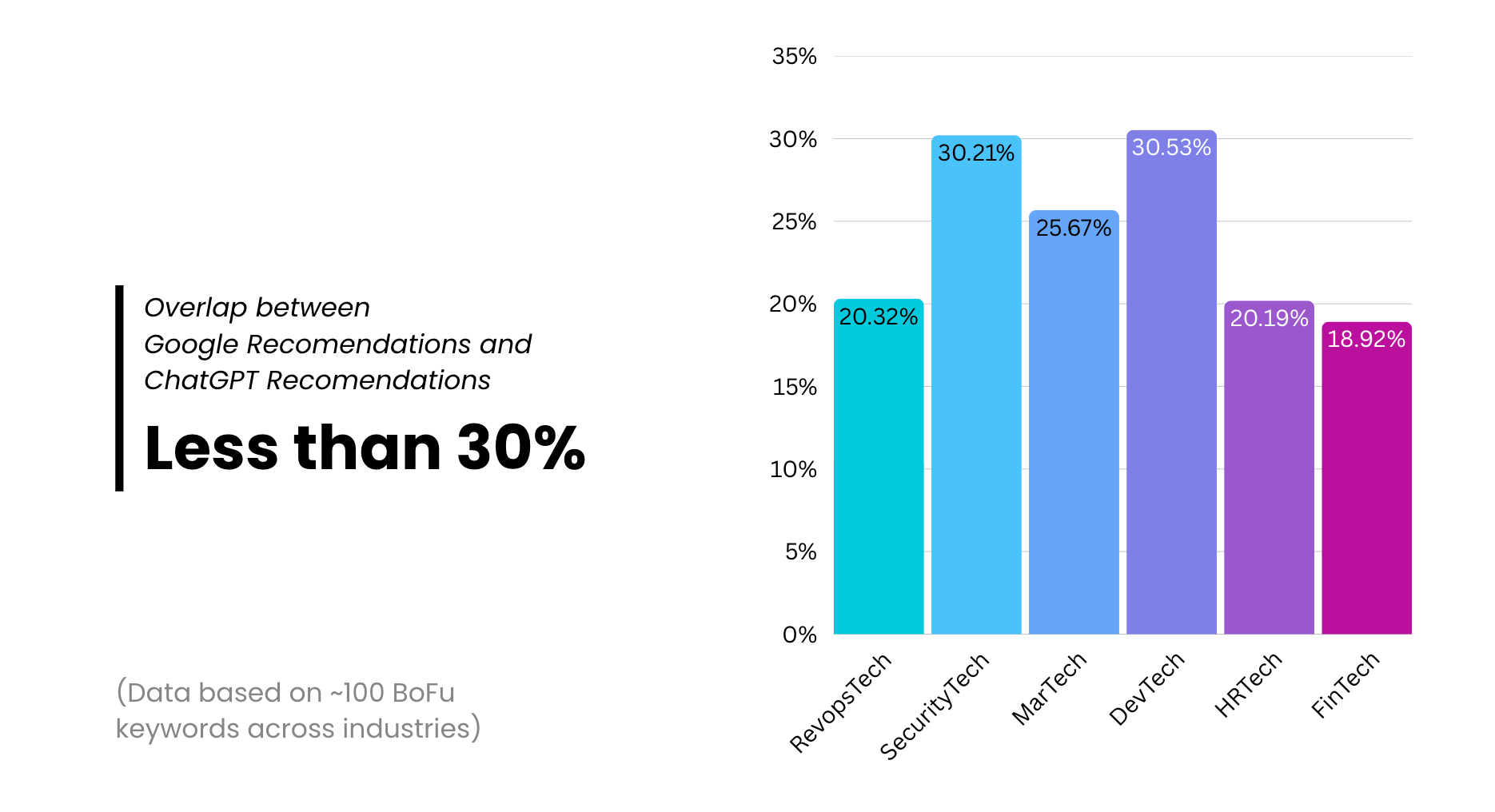
Simply put, even if you're ranking well on Google, you might still be invisible on ChatGPT. This critical insight underlines the importance of distinct AISO efforts.
Chosenly.com is a SaaS platform that helps B2B teams navigate this new optimization approach. But I'll also share how you can implement AISO independently.
There are 3 things you can do on LLMs that drive revenue.
- Show up for simple searches
- Show up for contextual searches
- Fix brand misrepresentations
1. Show up for simple searches
Less advanced ChatGPT users treat it like Google, performing straightforward searches such as "best CRM software."
What are simple searches?
These are short, high-intent, revenue-driving searches, similar to those done on Google.
What you can do to show up on simple searches (w/o having access to Chosenly.com):
Step 1: Pick the right searches:
Some people are using ChatGPT as a replacement for Google. I.e., the searches they do on ChatGPT are very similar to what they did on Google earlier.
So, the same keywords that worked for you for Google ads or SEO programs today will also drive revenue on ChatGPT, i.e., you just need to optimise for similar keywords across platforms. You may not have data for ChatGPT searches or search volume, but you do have data for Google search, so let’s use that.
Go to your Google Ads dashboard and Google Search Console dashboard (for SEO) to pick the keywords that are driving most of the pipeline.
If you have already connected your Google Ads account with your CRM such that the data flows through, you should be able to clearly see these keywords in your ads account.
If you're passing the value of these conversions as well, you should also be able to filter these by conversion value.
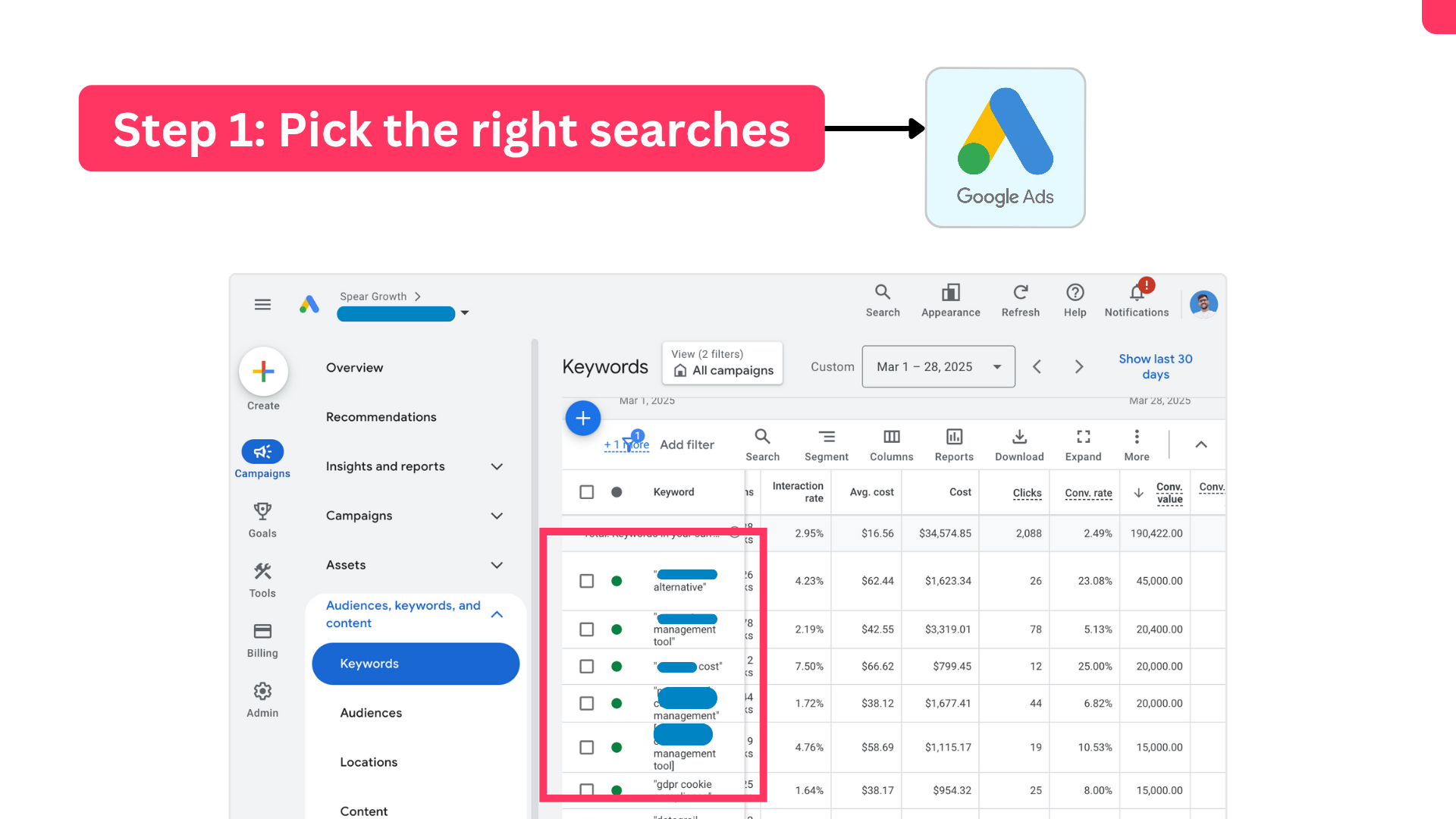
Even if you haven't set up the conversions, you should be able to see the contacts created in your CRM at a keyword level.
This means you can easily create dashboards to see demos, pipeline, SQLs, or anything else in your CRM.
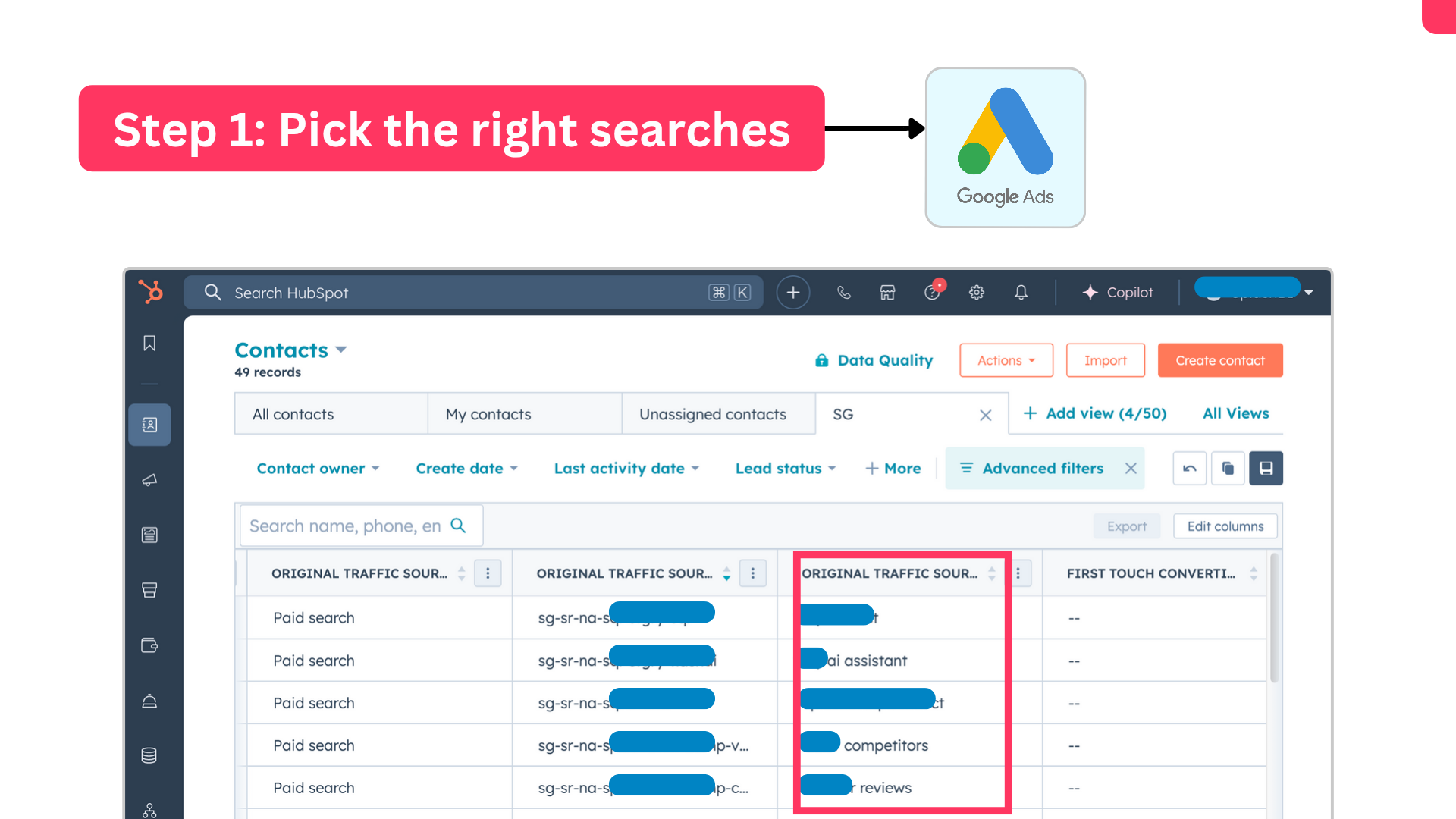
Doing this for SEO is not as straightforward.
Because you have your pipeline data in your CRM and your keyword data in your Google Search Console.
But you don't get to see the keywords in your CRM.
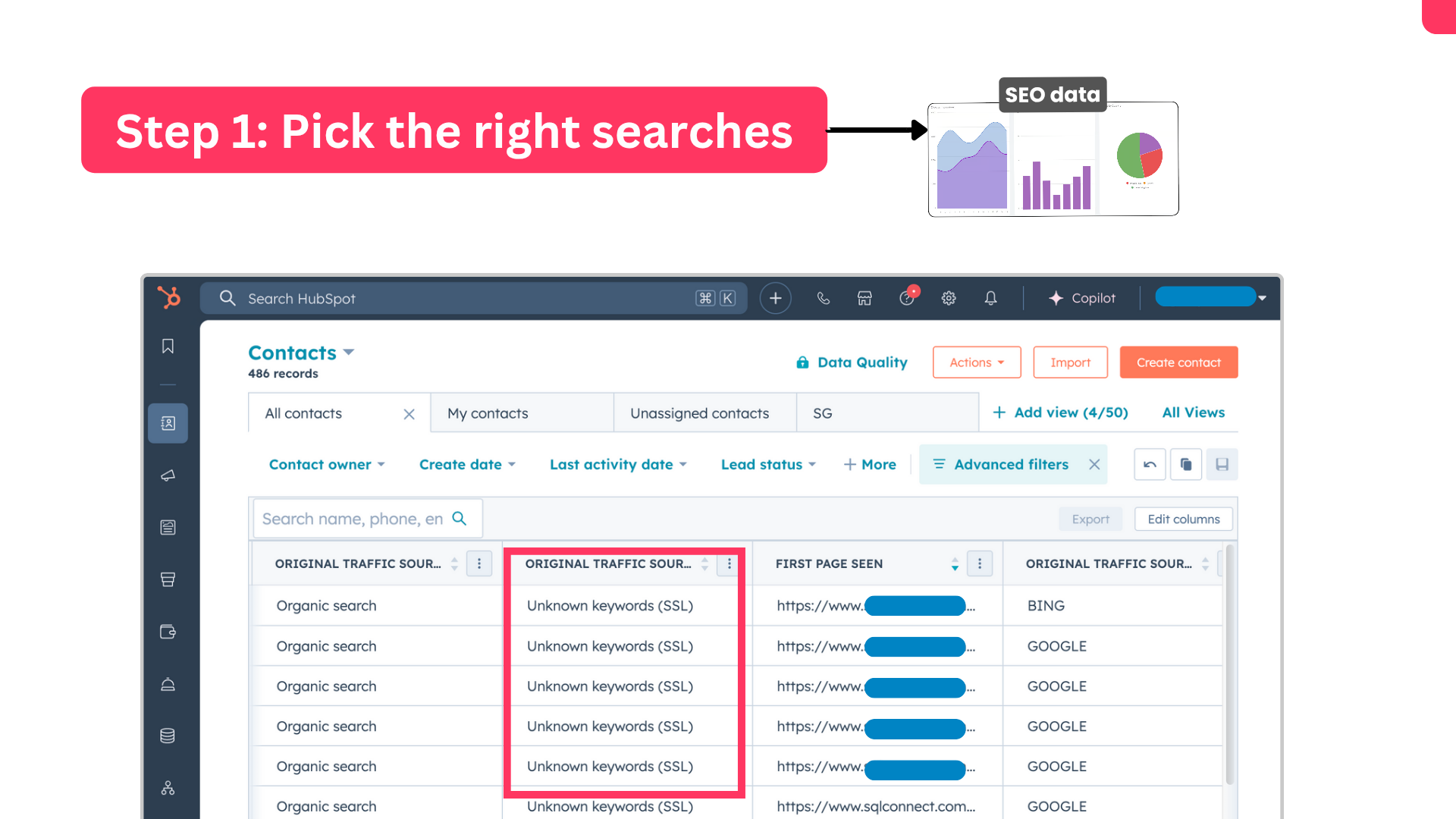
Nor can you pass the conversion data to your Google Search Console, where you do have the keywords data.
But you can estimate the keywords even in this case by following these steps:
- Download the page-level data in your CRMs mapped to the conversions.
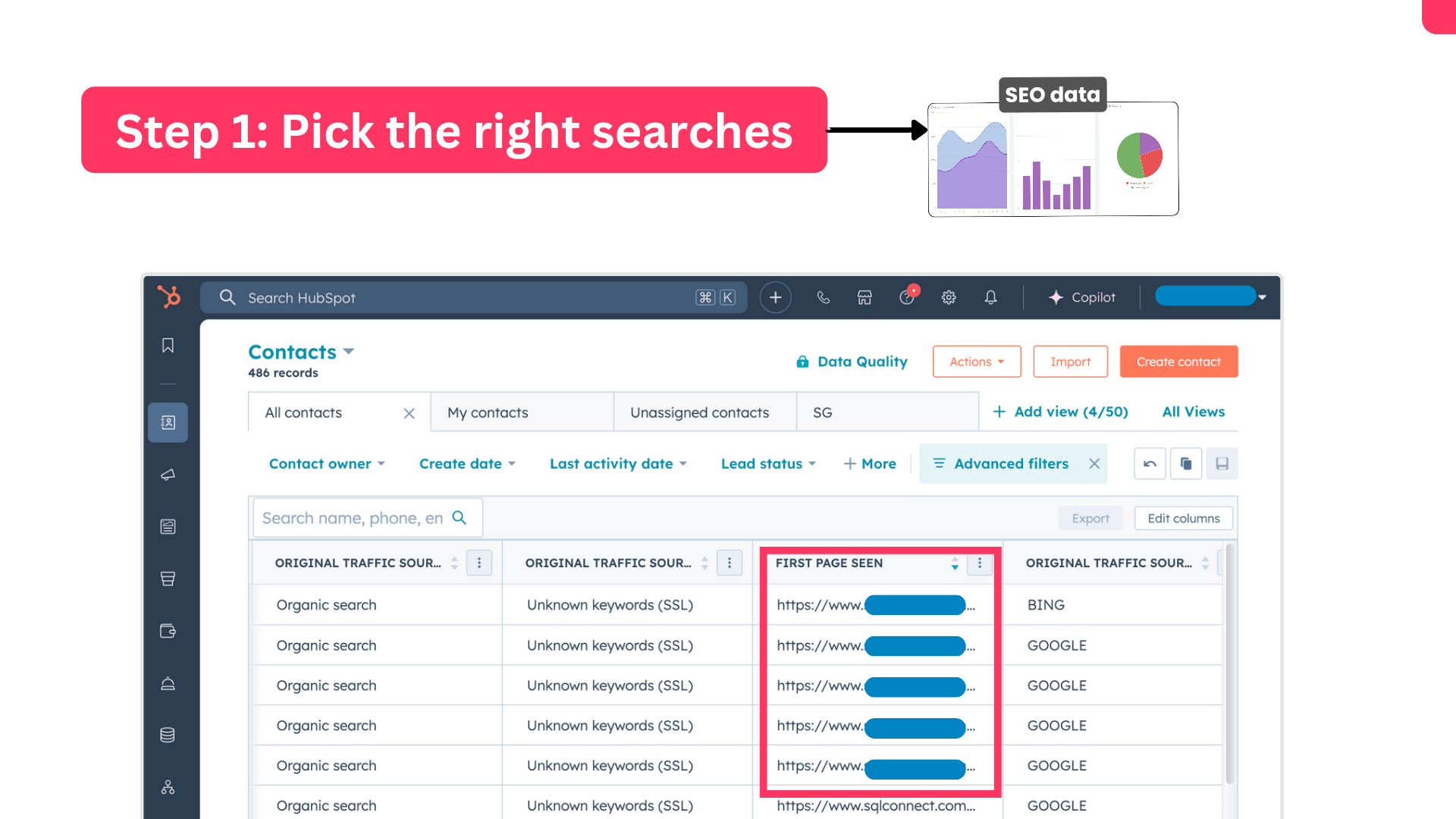
- Also, download page-level data in your Google Search Console mapped to keywords.
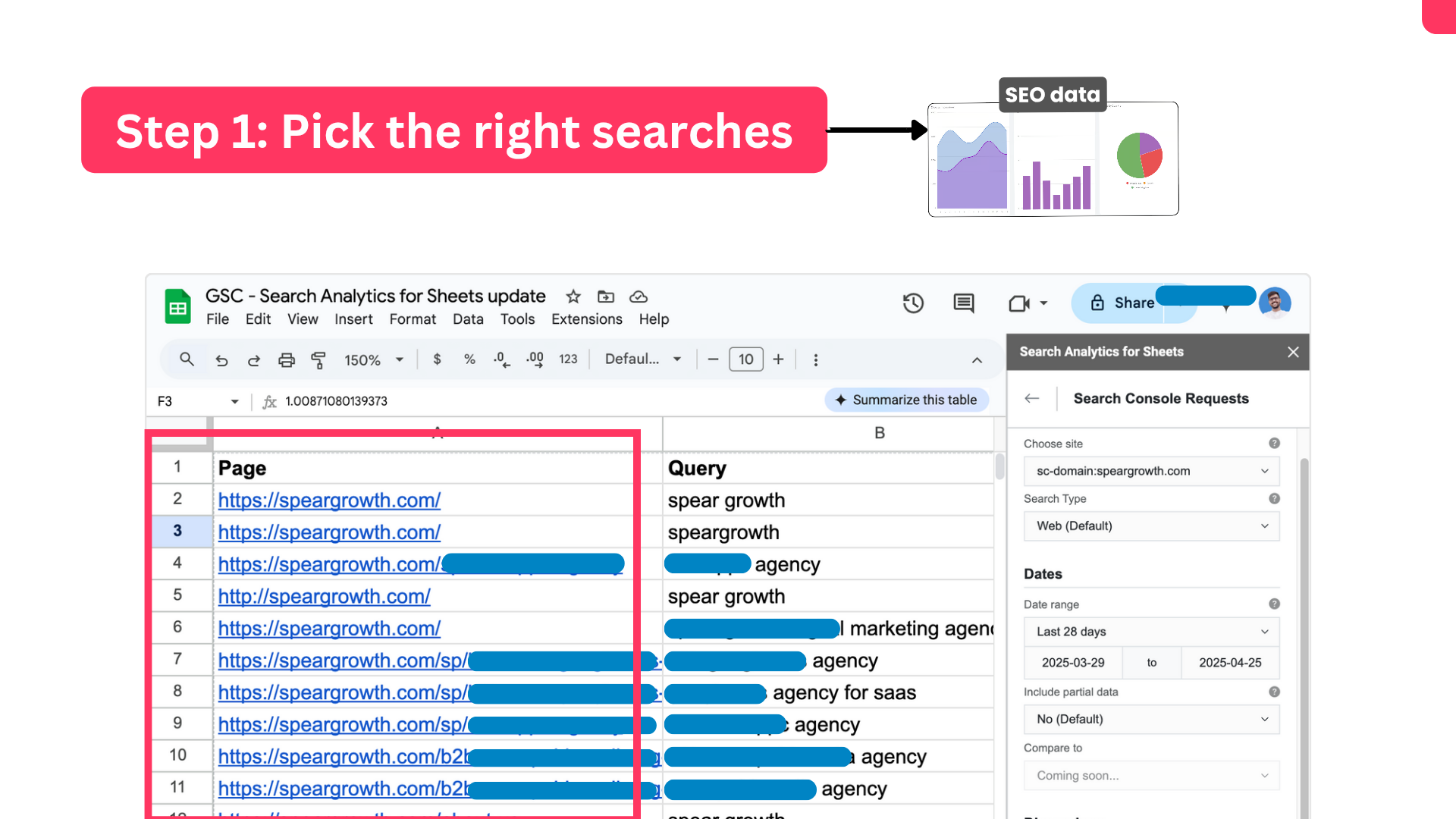
(I prefer extracting this into a spreadsheet using an extension called Search Analytics for Sheets)
- Put these in a single spreadsheet so you can run formulas on them.
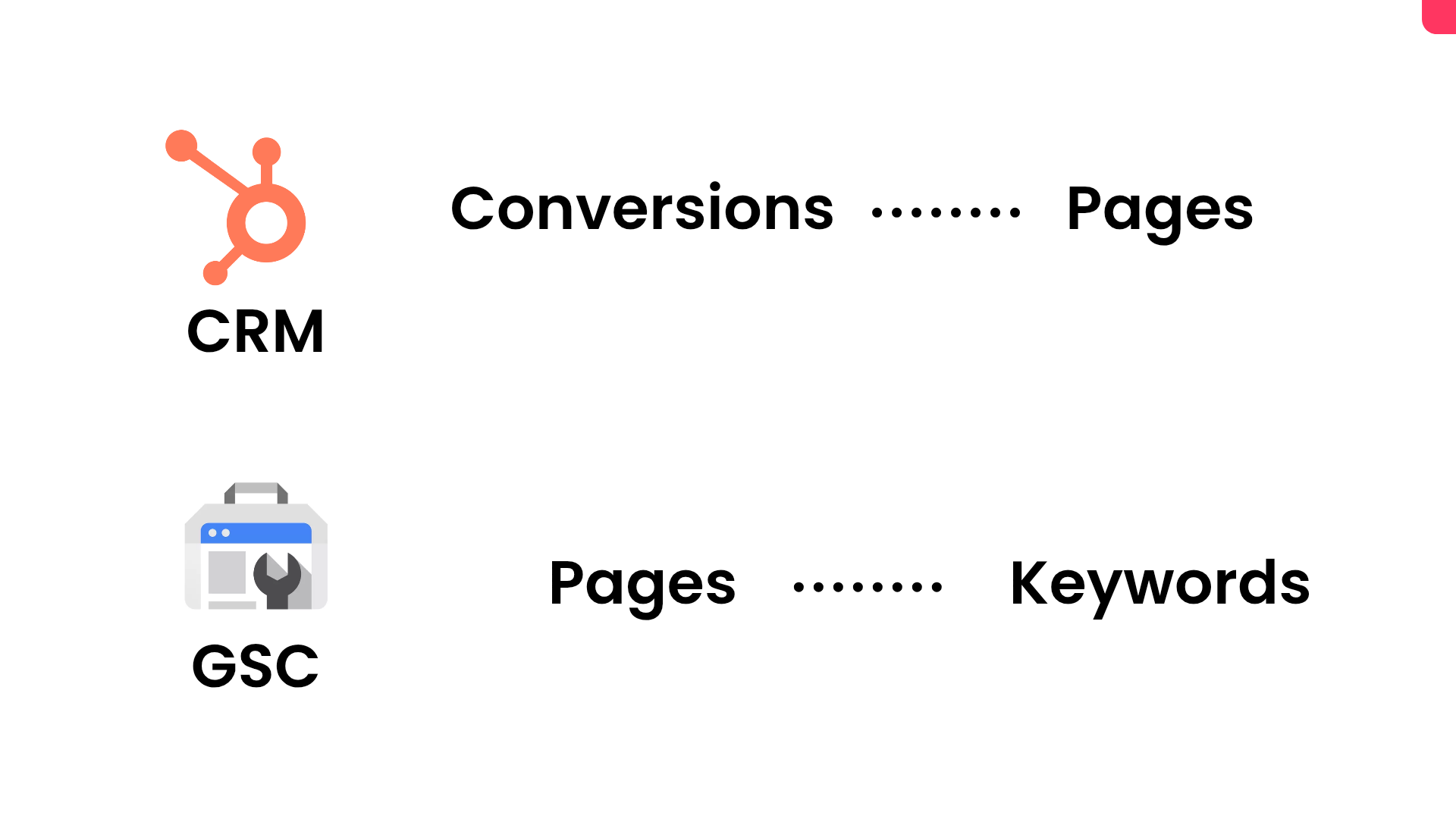
- Use the page-level data in both to estimate the keywords that you got your conversions from.
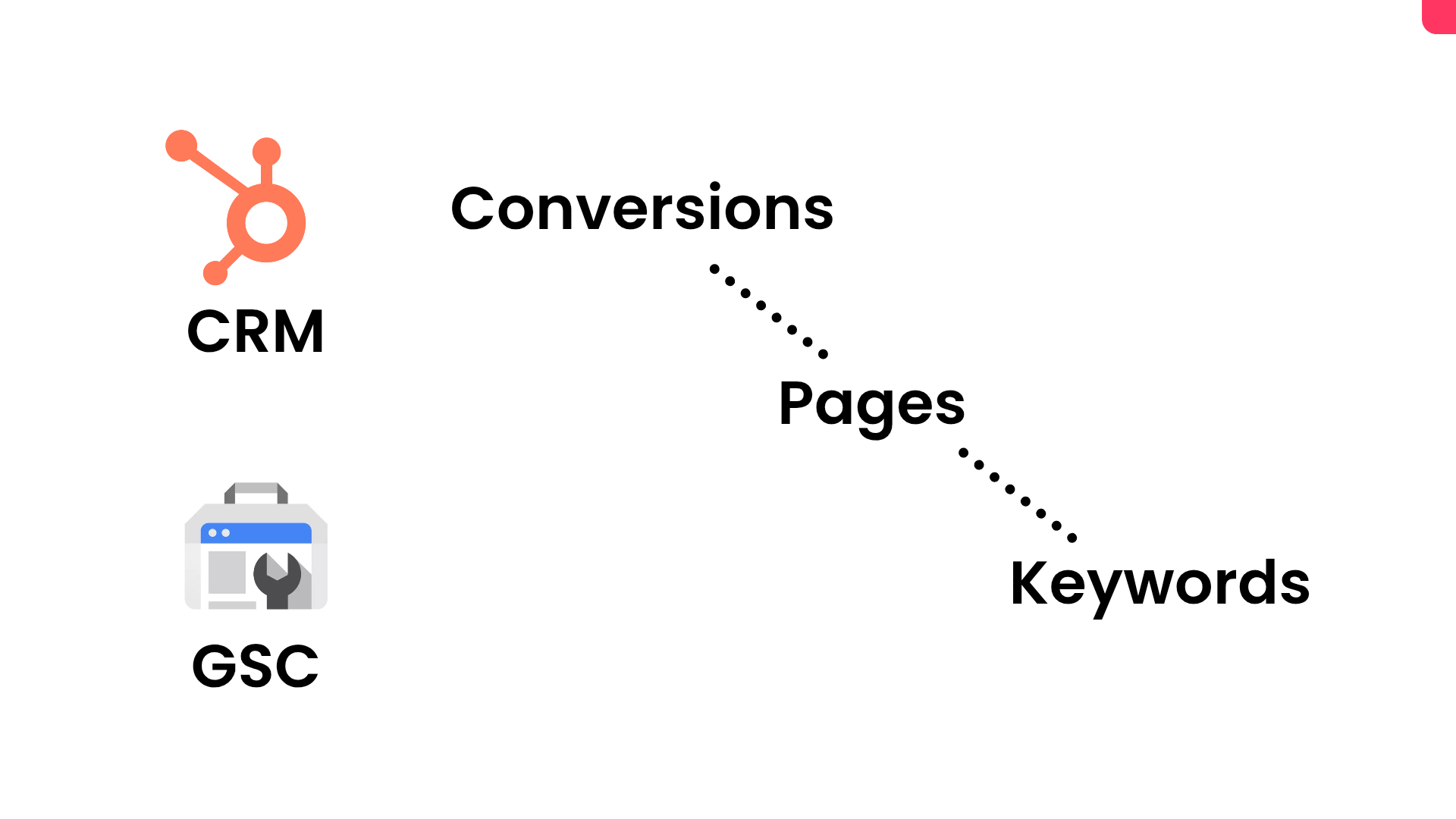
Now that you have your keyword list from your Google ads(paid search) and SEO(organic search) programs that are driving pipeline, you can use this as a starting point for the simple searches as part of your AISO program.
For most B2B SaaS companies, most of these keywords will be bottom-of-the-funnel searches.
Step 2: Estimate the sources:
ChatGPT automatically turns on web search for bottom-of-the-funnel searches even if the user doesn’t turn it on. The results are pulled not only from the data on which the LLMs are being trained but also mostly from actual pages that are currently live on the internet. We’re calling these pages "sources".
When you use the web search feature of ChatGPT, it shows you these sources at the bottom of the screen.
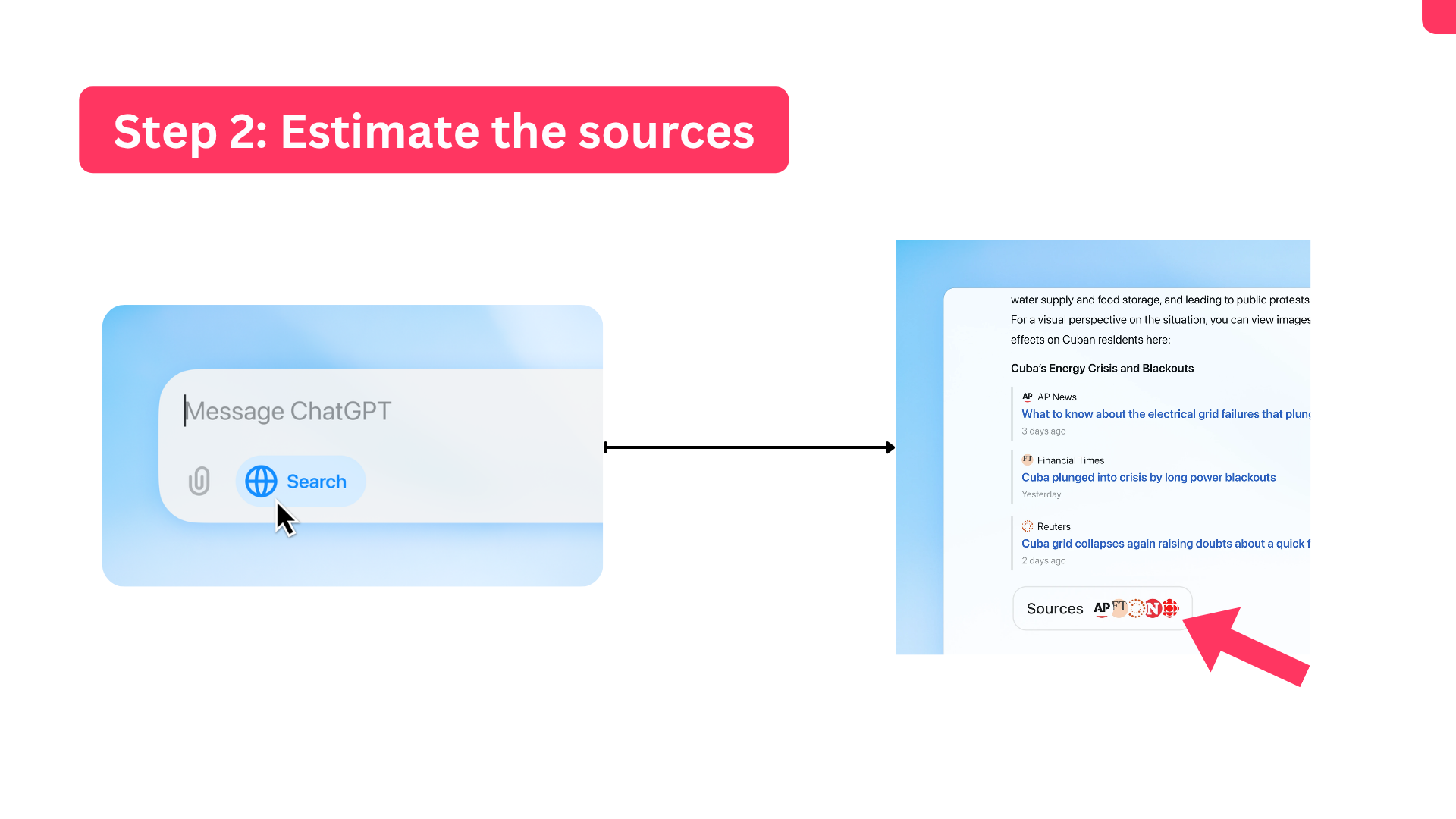
In Step 1, you estimated the searches; Now you need to estimate the sources used by LLMs to generate these searches.
- Create a spreadsheet (Tip: Type "sheets.new" in your search bar.)
- Search for the searches you had shortlisted in step 1(Pick the right searches) with the web search toggle turned on, on ChatGPT.
- Copy-paste each of the sources for each keyword into the spreadsheet you created. This is the unfiltered list of URLs you need to show up on.
- Use the Google Sheets formula =unique() to remove duplicates from this list.
- Copy-paste the sources it references to the spreadsheet.
That’s it! Now you have a list of sources you can use. This simple approach will help you find 40-60% of all the sources you need to care about.
Step 3: Targeted outreach/PR
Secure placements on these influential sources. ChatGPT favors PR articles, research papers, and listicles, sometimes even referencing preview sections of gated research content.
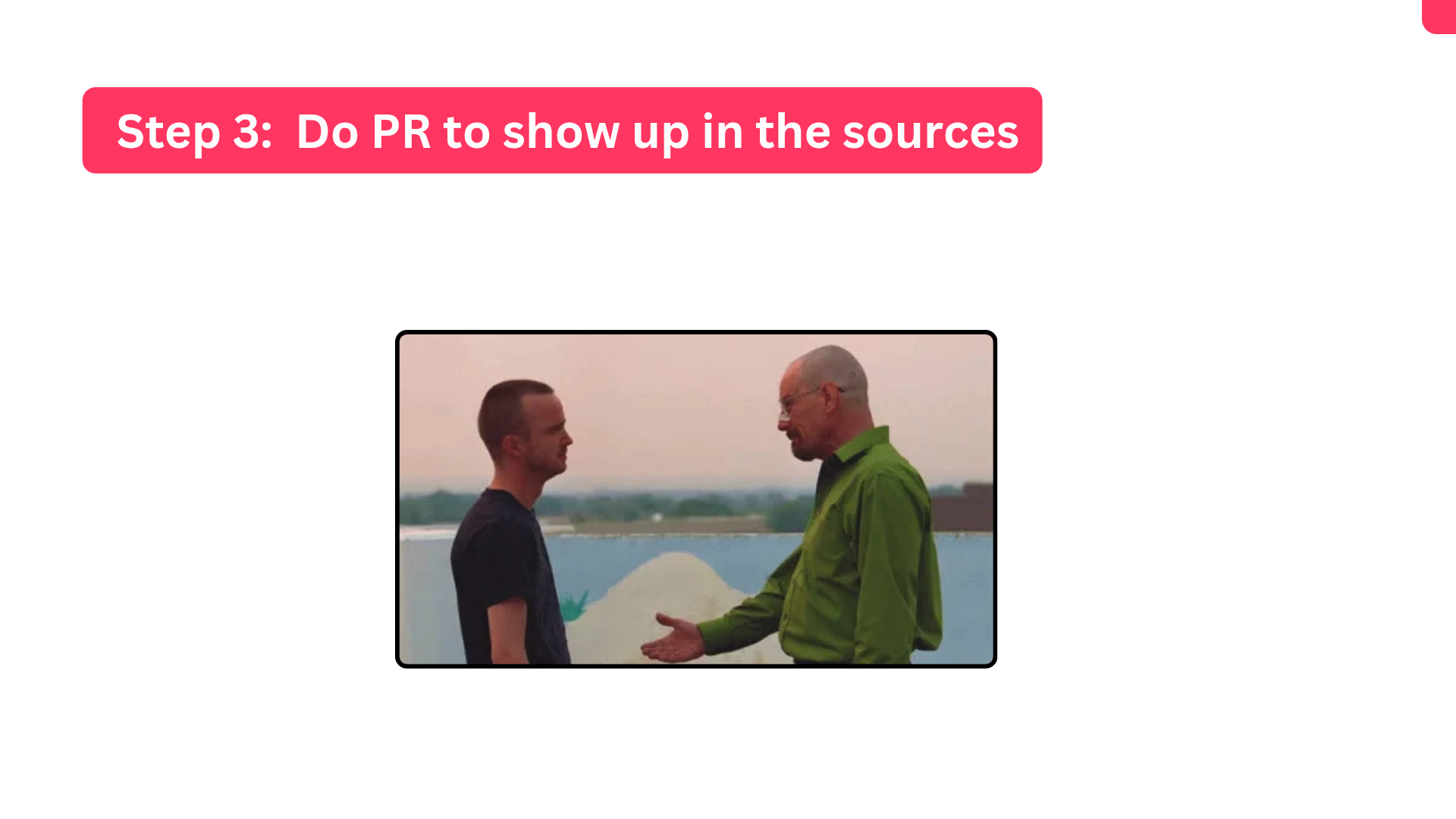
So do PR to show up in the sources. Reach out and pitch yourself. You can try giving them something in return for you getting placed there, build a relationship with the author that wrote it, or follow literally whatever playbook works for you to show up there.
Some recent tactics we've used to get our clients listed are:
- Back scratching: Reach out to competitors with listicles being used as sources. Tell them you'll include them in your top 10 list in exchange for them including you in theirs.
- Paying the editor: Especially PR websites have dedicated forms you can use to request for quotes to an article.
- Relationships: Being in the space for a while, we have built relationships with a lot of SaaS writers and editors, or we know someone who knows them. That helps open dialogue.
- Offer a rewrite: Very often, these articles that are being referenced are old and not as in-depth. Some editors love the idea of getting it refreshed.
- Offer something unrelated but valuable: We've offered part of our SEO services in exchange for getting our clients listed.
With Chosenly.com you can do a lot more to show up in simple searches:
The manual process I've just outlined is pretty comprehensive, but there are a few catches to it:
- It takes a very long time to just collect the sources
- It doesn't take into account that ChatGPT generates different answers for different users
- The list you get from it isn't prioritised so it's hard to come up with next steps
- Just finding out who to reach out to in companies that own simple searches is painful.
Even though it's the best approach you can do manually, it's inefficient and only helps you find 40% of the sources you should go after.
Chosenly.com deals with all of this for you. Once you log into your dashboard, you'll see this:

- With Chosenly.com, you save at least 8-12 hours of work you'd have to do to collect the sources manually. With us, you can just connect your Google Ads and Google Search Console accounts, which it uses along with other sources to generate a final list of keywords automatically.
- We automatically handle the account-to-account variations to a large degree. It's impossible to get all the variations, but Chosenly.com manages to get a wide variety of them... again, automatically.
- The list of sources you need to go after is already prioritised in Chosenly.com. Getting into sources is tough. We make sure you don't waste time and resources going after sources that'll have a minimal impact.
- We have also built a campaign feature that helps your team/agency find people to reach out to. (Beta)
2. Showing up for contextual searches
More advanced LLM users talk to LLMs the way they'd ask for recommendations from a peer or in a community.
We interviewed ~20 decision-makers at B2B SaaS companies and also a few enterprise B2B companies to understand how they use ChatGPT.
We realised more advanced ChatGPT users provide detailed, context-rich prompts. I.e., they talk to LLMs like they speak with humans because they respond like one.
Previously, these queries were discussed in communities, peer-to-peer interactions, or closed networks. ChatGPT is rapidly replacing these closed-network conversations, particularly among harder-to-reach personas like CFOs.
Sample contextual search:
"I am a CFO at a Fintech company based in Europe. We have 7 people in our finance team. We use X as our ERP. I am looking for a financial reporting software.
We have a budget of Y. Recommend the best software for me."
What are Contextual Searches?
Contextual searches are prompts made on LLMs like ChatGPT that are rich in context. They have no search volume and much higher purchase intent.
Why no search volumes? Because these are made by including a lot of details about the preferences of the searches and their writing style. It'll be rare for you to ever see it.
These are not searches that would ever happen on traditional search engines like Google. These are questions people would share in communities.
In our interviews, we found that decision makers were very aware and often even more annoyed by ChatGPT hallucinations. But, for some reason, once the web search toggle is turned on, people seem to really trust ChatGPT's recommendations and don't think it hallucinates. i.e., showing up for these recommendations is critical.
This completely breaks the SEO-like playbook we have been following. So, how do we show up for these?
Which contextual searches should you optimise for?
You won't get a list of contextual searches with their search volumes to optimise for.
We've already discussed how these are one-off searches, so they don't really have a search volume.
I, Ishaan Shakunt(CEO of Chosenly.com), also believe that companies like OpenAI won't ever share what contextual searches their users are doing via a tool like Google keyword planner or search console because people are adding too much confidential personal and professional information. If companies like OpenAI actually shared this information they'll lose a huge share of the market. At max Ishaan expects LLM companies to share this data grouped by themes like topics.
But you can still get a list of data to optimise for. To understand this, let's break down the sample prompt we shared.
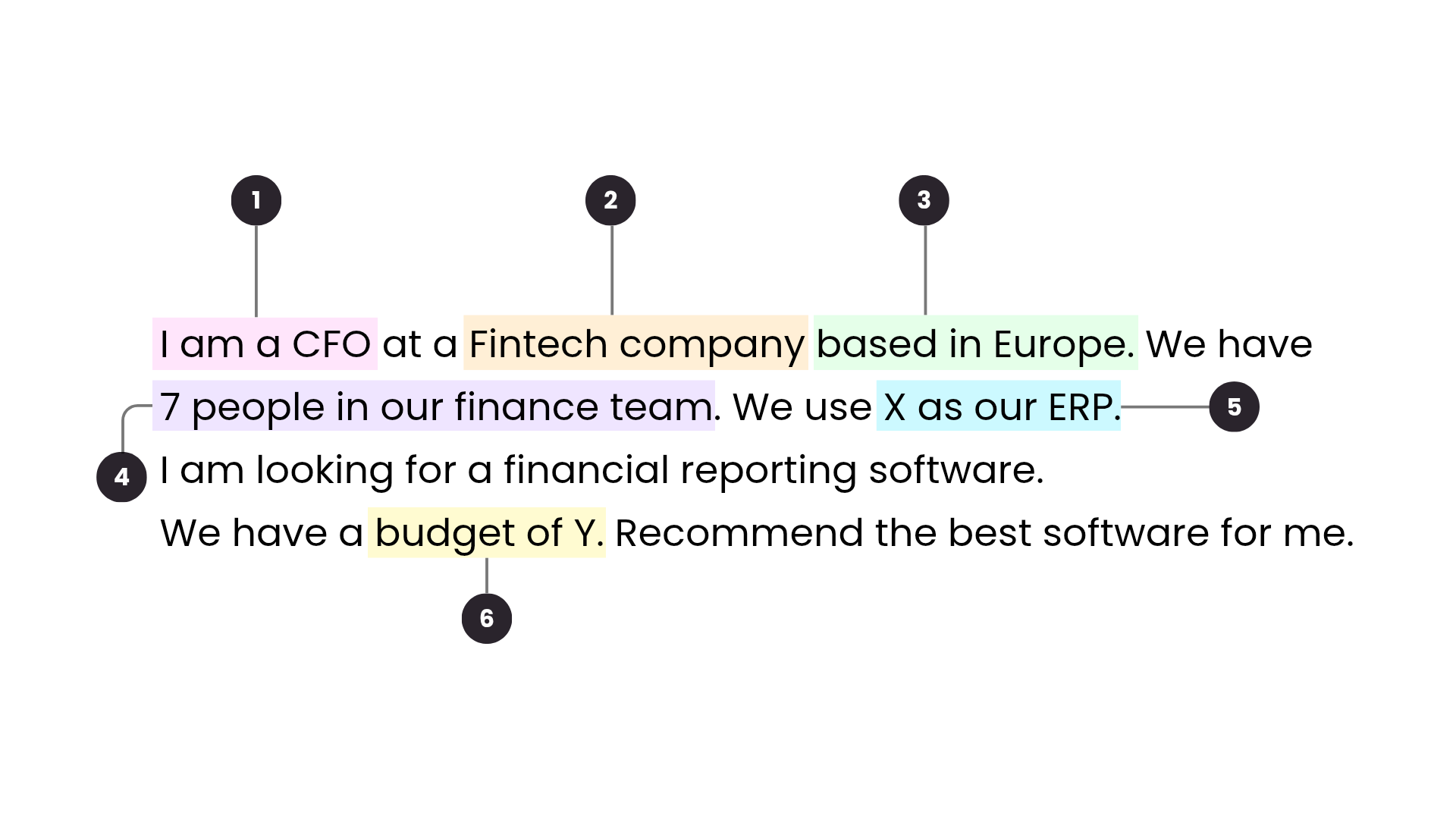
Most bottom-of-the-funnel contextual prompts can be broken down into multiple criteria that the searcher(decision maker) has when looking for a solution/vendor.
LLMs like ChatGPT "believe" that different solutions/vendors are a good fit for each criterion.
So to be recommended by LLMs for contextual searches, you need to make LLMs "believe" that you're a good/the best fit for as many of the identified criteria as possible.
How to get ChatGPT to recommend you for contextual searches?
Let's first take the same prompt I've shared earlier, and how we can give information to ChatGPT, making it clear that we're a great fit.
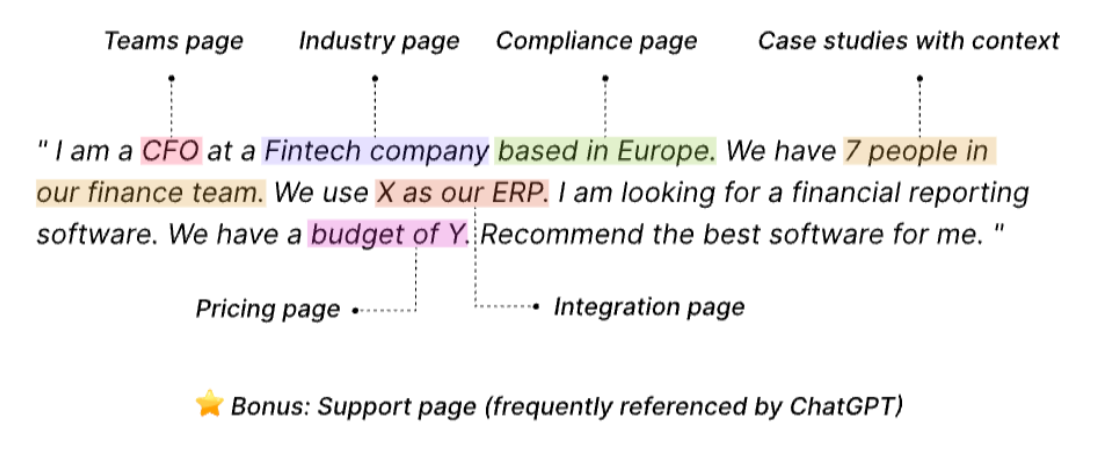
- Are you a good fit for different roles like CFOs? - You can potentially answer this by having different teams' pages.
- Are you a good fit for different industries like Finance companies? - Industry pages.
- Are you a good fit for companies based in the Europe? - ChatGPT is pretty good at understanding that a financial reporting tool for European companies should probably comply with GDPR. So the actual question is: Do you have the compliances your audience needs you to have? - You can showcase this in a single compliance page.
- Are you a good fit for companies with 7 people in their finance teams? - You probably can't create pages for every team size out there. In this case, we recommend adding more context to your case studies. Add information about the companies you've worked with to your case studies.
- Are you a good fit for companies with a certain budget? - For some companies, this is simple; Just create a pricing page. But for a lot of sales-led companies, this may not be possible. In those cases, I recommend still creating a pricing page but adding information that will at least help ChatGPT estimate your pricing. Eg: Are you typically 30% less expensive than your competitors? Do you usually charge less than 10% of the team you replace? How fast does an average client break even on their investment?
If you did a search like this, you'll find that ChatGPT definitely takes the criteria in the prompt as evaluation criteria, but it also adds its own criteria.
For B2B SaaS, across the 100s of searches we've reviewed, the most common criterion we've seen it add is that the SaaS platform should have great support.
Very few B2B SaaS companies have support pages. But if you did, I recommend you add information about stats like average reply times, the structure of your team, or testimonials from your customers stating how good your support page is.
Ending notes:
- If ChatGPT can find these details about your competitors but not about you, it will recommend your competitors.
- Your website is not the only source of this information. But it's often one of the top sources (especially for competitor v/s you type searches). Just having this information on your website lets you control the narrative much more than other sites that you usually have much less control over(including review sites like G2 and Capterra, or listicles/competitor pages written by your competitors).
Now that you understand how this works, let's help you create a contextual search ranking program for your company.
What can you do to show up on contextual searches (w/o having access to Chosenly.com)?
Here are the steps to follow if you're doing this without our tech:
- Finalize the criteria you want to optimize for
- Make sure you have the information on your website
Step 1: Finalizing the criteria to optimise for
There are 3 sources for you to collect this information from:
1. The standard list of criteria that you saw a couple of minutes ago. The list of most common criteria we've collected for B2B SaaS companies. We discussed this in the last section, but also refer to the image below for a refresher.
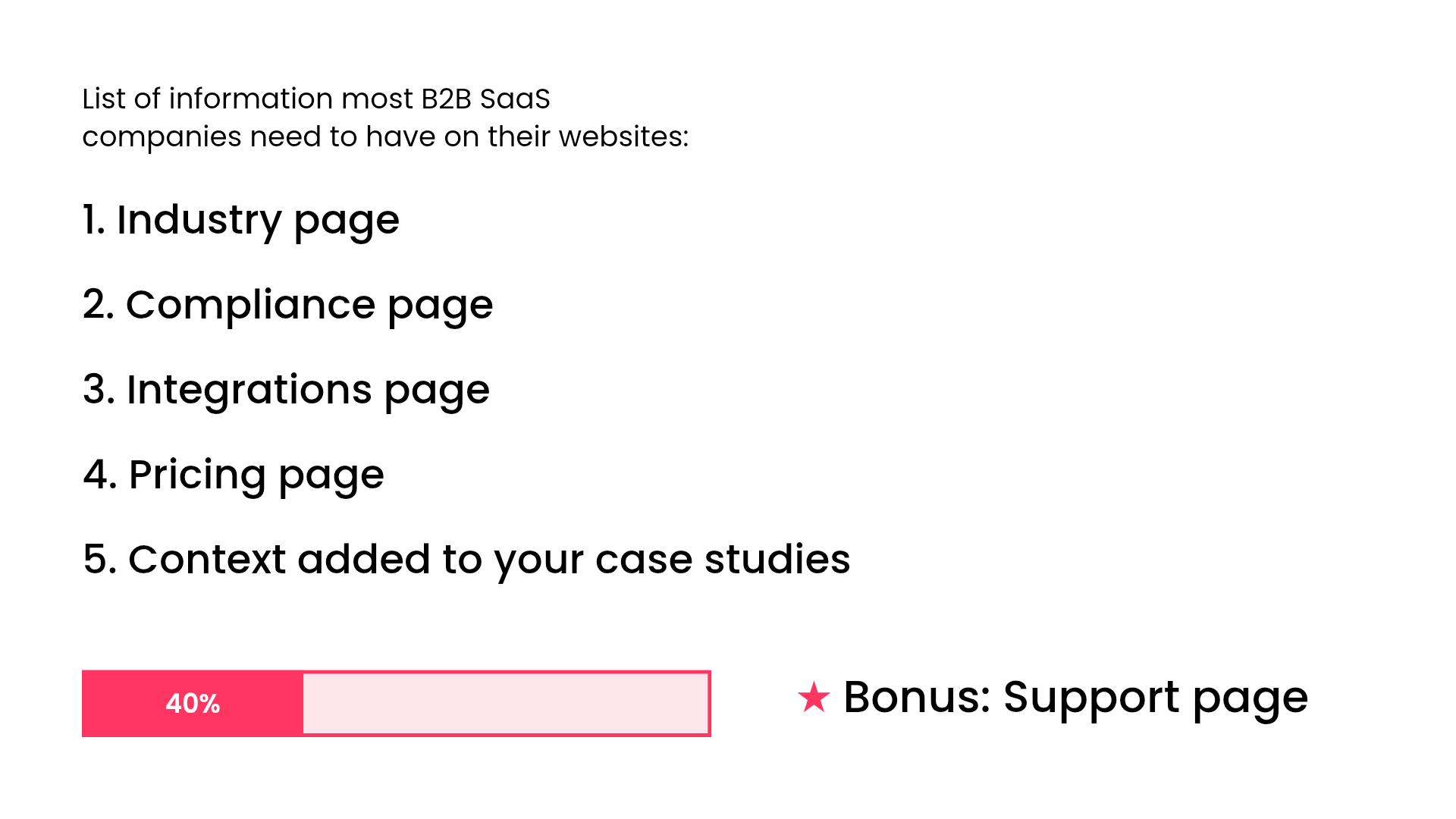
- The set of criteria that you know your target audience judges you on. Collect these from your sales teams. (Sales teams often call these DCMs or decision making criteria.)
- This is the one that throws people off- The set of criteria that ChatGPT thinks software/vendors in your category should be judged on. (Sadly, it's not possible to get these without having access to Chosenly.com. So, we'll ignore this for now.)
Compile our standard list and the criteria you've collected from the sales team. This will help you cover 40-60% of all criteria you should optimise for.
So, we're on to our next step-
Step 2: Adding information to your website
You can create separate pages to add this information, or you can add the information to existing pages.
Here are a few examples of how you can do this for reference:
| Page Type | What to Include |
|---|---|
| Industry Pages | - Industry-specific headers (e.g., "[Product] for Fintech") - Pain points + your solutions - Use cases - Testimonials/logos - Compliance details - Case studies - Industry FAQs |
| Compliance Pages | - List of standards (GDPR, HIPAA, SOC2, ISO) - How your product meets them - Certifications & badges - Compliance FAQs - Downloadable resources |
| Integration Details | - Integrations by category (CRM, ERP, Finance) - Use-cases or workflows - Screenshots or diagrams - Setup instructions - Links to docs |
| Pricing Information | - Pricing plans (monthly/yearly/enterprise) - Budget ranges or examples - ROI statistics - Pricing FAQs - Quote request option |
| Case Studies | - Client overview (size, industry, location) - Business challenges - Detailed solution + metrics - Testimonials - Relevant integrations/compliance |
| Support Page | - Support channels (email, phone, live chat) - Response times - Resource library (FAQs, guides) - Support testimonials - Team structure - Awards |
With Chosenly.com you can do a lot more to show up in simple searches:
Just like last time, the manual process I've just outlined is pretty comprehensive, but there are a few catches to it:
- You cannot find the criteria ChatGPT uses to evaluate software in your criteria, irrespective of whether or not your audience adds them to their prompts when searching.
- Your list of criteria isn't prioritised, and adding this information is a huge undertaking. Each page answers critical questions about the business, and this cannot be outsourced. Someone from the product marketing team or a senior marketer would have to collaborate across teams to create this. So, having a priority list is important.
- You don't know where you're already a good fit and for which of your ICP. Knowing this would have also helped you with prioritisation. If you're already "winning" for a few criteria, you can double down on them later.
- You're focusing on creating content on your website, only following best practices and common knowledge. You don't know why or how ChatGPT is recommending someone today.
We faced these exact problems when doing this as a service for our clients. That's why we built Chosenly.com.
This is what the Chosenly.com dashboard for contextual search looks like:

Chosenly helps you:
- Find the criteria ChatGPT deems important for your industry.
- It merges these criteria with the criteria collected from your sales team and prioritises them for you. This way, when you decide to spend all that money and effort into creating a page, you can be sure it's the best use of your team's time, energy, and focus.)
- It shows you which competitor of yours is getting recommended today for each of your personas.
- (And my favourite feature) It estimates why someone is recommended. (And sometimes ChatGPT makes wild assumptions. Eg: For one client of ours, it claimed that our client's competitor had the best support simply because they won a few awards that had nothing to do with support.)
- It also shows other sources ChatGPT is using to collect this information. (This surprises me very often- PR websites sometimes are the top information sources, other times we see ChatGPT referencing product review websites that I haven't ever heard of, more than the popular ones like G2/Capterra)
3. Fix Brand Misrepresentations
LLMs lie with confidence and your audience believes it.
LLMs talk with confidence and, for most high-intent (Bottom of the funnel) searches, they also cite sources. I told you how, in our interviews, we realised that decision makers don't tend to question what it says. When I asked them a few more questions about it, this is what we realised:
Decision makers and their teams are using LLMs to shortlist the top 3 solutions/vendors. Then they rely on manual research to finalize who they'll actually select.
How do brand misrepresentations happen?
There could be a lot of reasons for LLMs to "lie" about your brand. A few common ones our clients have seen:
- Misunderstood the page (eg: picked the wrong information about your brand's price because the page was hard to read.)
- Used information from a review platform out of context
- Picked information from an outdated page of a website
- Your competitors were claiming you don't have a feature, you actually do
Apart from lies, there could also be other information you may want ChatGPT to not highlight in its answers. Like negative reviews, or information about data breaches in the past.
Controlling your brand's narrative on LLMs is important. But if it is lying about you, what can you do about it?
How can you fix brand misrepresentations?
Here are the steps:
- Find misrepresentations.
- Correct the misrepresentations at the source where possible.
- If you can't fix at the source, flood the internet with pages that align with your narrative.
What can you do to fix brand misrepresentations (w/o having access to Chosenly.com)?
Step 1: Finding misrepresentations
This is hard without software like Chosenly.com. We tested a lot of prompts to try to make this process as simple as we could to do manually. It's not perfect but here's a prompt we found that gives you a good 20-30% of the most important misrepresentations for your brand:
"I work at [company name]. My competitors are [comp 1, 2 & 3]. I sell to [job titles] at companies that are [company definition]. Create a table comparing me with each competitor, using criteria our audience cares about."
When you get the answer, manually mark anything that you believe is untrue
Step 2: Correct the misrepresentations at the source
For this, you'll have to rely on two approaches if you don't have access to Chosenly.com.
First, start with a simple Google search. Search for your misrepresentation directly, then search again with quotes("") around the misrepresentation. You may find a website that's the source of that information.
If that doesn't work, try asking ChatGPT with web search turned on. "Give me a list of sources on the internet that claim {misrepresentation}." Check both what ChatGPT says in the answer ChatGPT generates and also the list of sources it used to generate the answer.
Step 3: Flood the internet with pages that align with your narrative
If you can't find the source or you don't have control over changing what it says, you may have to resort to this.
Across all our clients, when there is a misrepresentation, it's usually because of 1-2 sources at max.
So, as a rule of thumb, you can publish 3 pages with your narrative to fix the brand misrepresentation.
- On your website
- On a website where it's easy to publish content, but we know ChatGPT uses to generate its answers (like Reddit or LinkedIn answers)
- A PR website (like PRweb)
This is a great place to start and often enough to fix the misrepresentation to a large extent.
With Chosenly.com you can do a lot more to show fix brand misrepresentations:
Step 1: Finding misrepresentations
When you log into our tool, it will show you a couple of potential misrepresentations by default. It'll also show you any negative claims LLMs are making about your brand. You can use these to easily find misrepresentations.
If you want to dig deeper, it will also show you a lot of important statements ChatGPT makes about your brand that you may want to check and flag.
Step 2: Correct the misrepresentations at the source:
Chosenly.com finds the sources of the misrepresentations for you within a couple of minutes of you flagging them. Its output is also much more reliable than the manual approach I recommended earlier.

With this information, you can create a solid plan. It may include:
- Delete/update pages on your website or company profiles under your control. Eg: A client saw that ChatGPT was picking up information from product profiles they had made on a review website that they missed updating after changes to the product.
- Deal with negative reviews when possible. Eg: Some review sites let you pay them to delist some of your negative reviews.
- Deal with competitors mentioning negatives about your brand that may not be true or may not be public information. Eg: You are well within your rights to send them a legal notice to take down the information. That usually is enough.
You get the idea. Creating a solid plan is pretty straightforward once you have the data in Chosenly.com.
Step 3: Flood the internet with pages that align with your narrative
Using Chosenly.com, you typically don't need to rely on this step because you can do step 2 reliably. (Which is great because actually implementing step 3 can get pretty annoying.)
Should you invest in an AI search optimization program?
Spoiler: The answer isn't a clear yes.
Traffic from LLMs is blowing up.
Chances are that you're already seeing pipeline being driven from LLMs. This is pretty easy to check because all popular LLMs add UTM parameters to their links, so you can see it in Google Analytics, your CRM, or most other marketing analytics platforms.
At the start of the guide, I shared how both high-ACV demo-led companies and low-ACV free-trial-led companies are seeing significant pipeline impact from the traffic from LLMs already.
Note: All of these results are just based on last touch attribution, ignoring everything else. So we're still underestimating the impact.
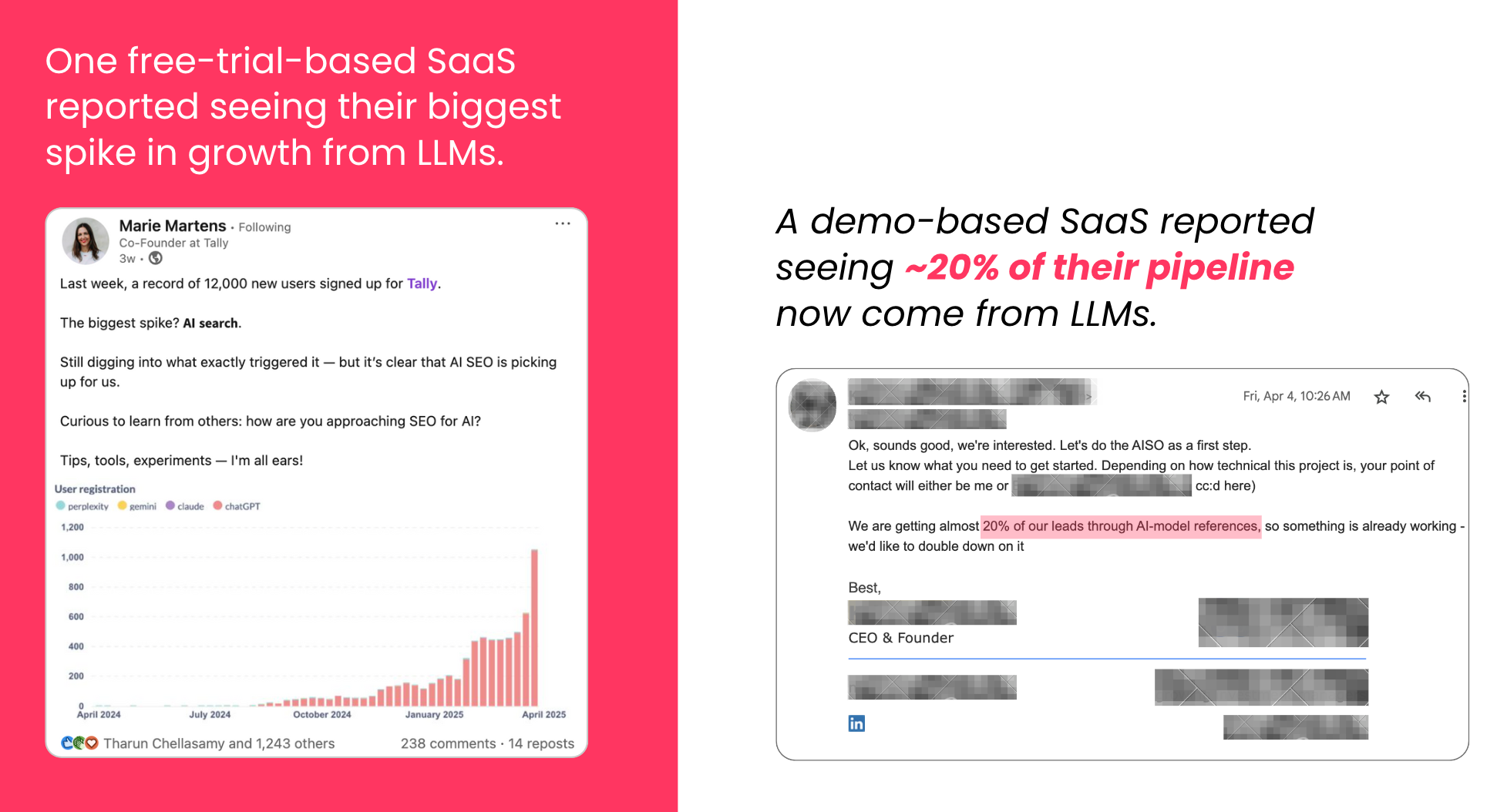
This is pretty exciting because we all know that LLM usage is still blowing up. It is only speeding up.
Just in this guide we've discussed how it's taking up an increasingly higher share of search, it's also taking away questions that decision makers would have asked their peers or in communities, but we haven't yet discussed how LLMs are also some of the greatest social listening tools that have been build yet.
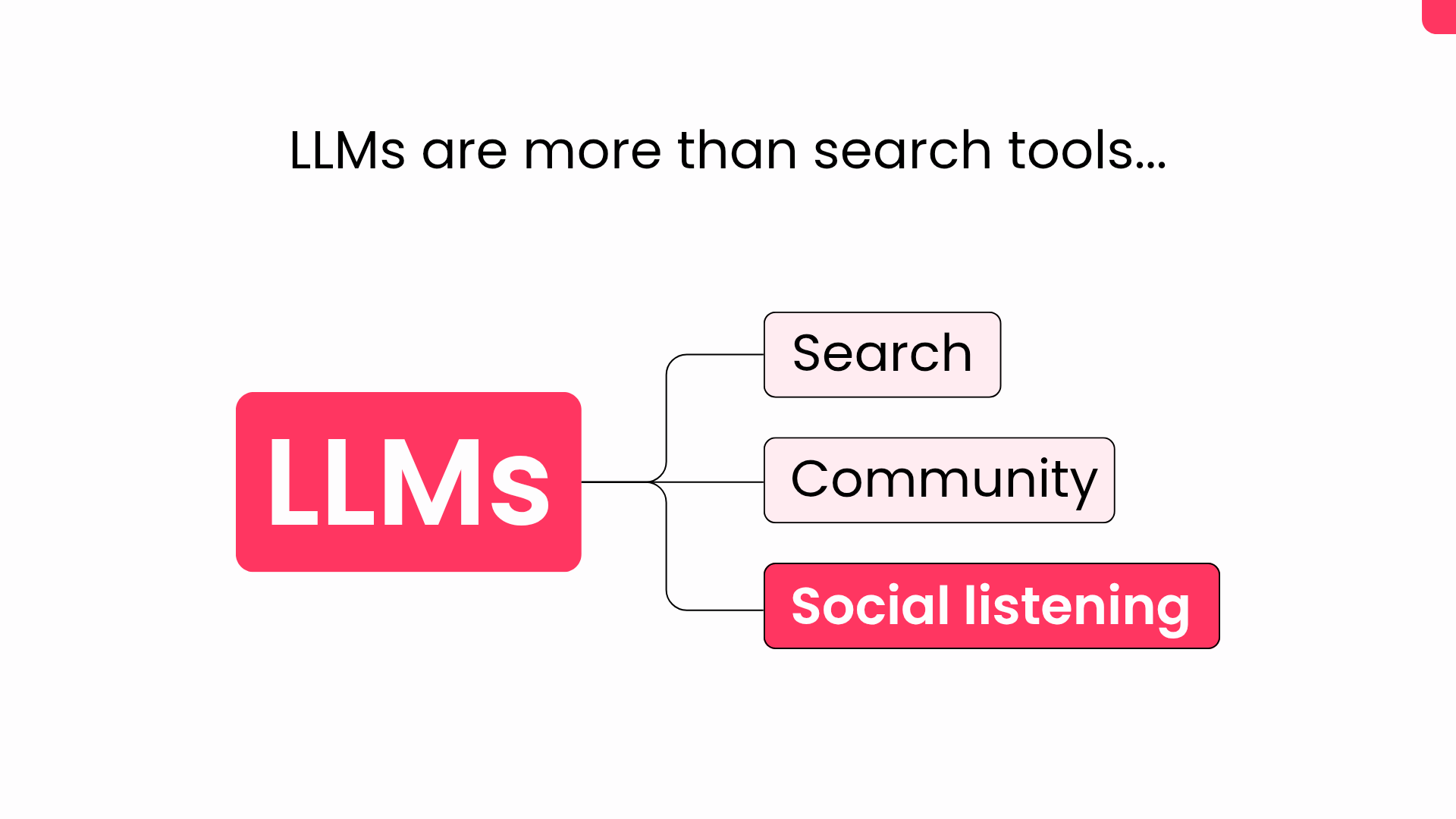
In a sales process, the decision makers collect some information from speaking with your sales team or going through your free trial. But users have also increasingly been doing a lot more self-research. This is especially true for millennials now reaching positions where they're decision makers. (Like me ✌️)
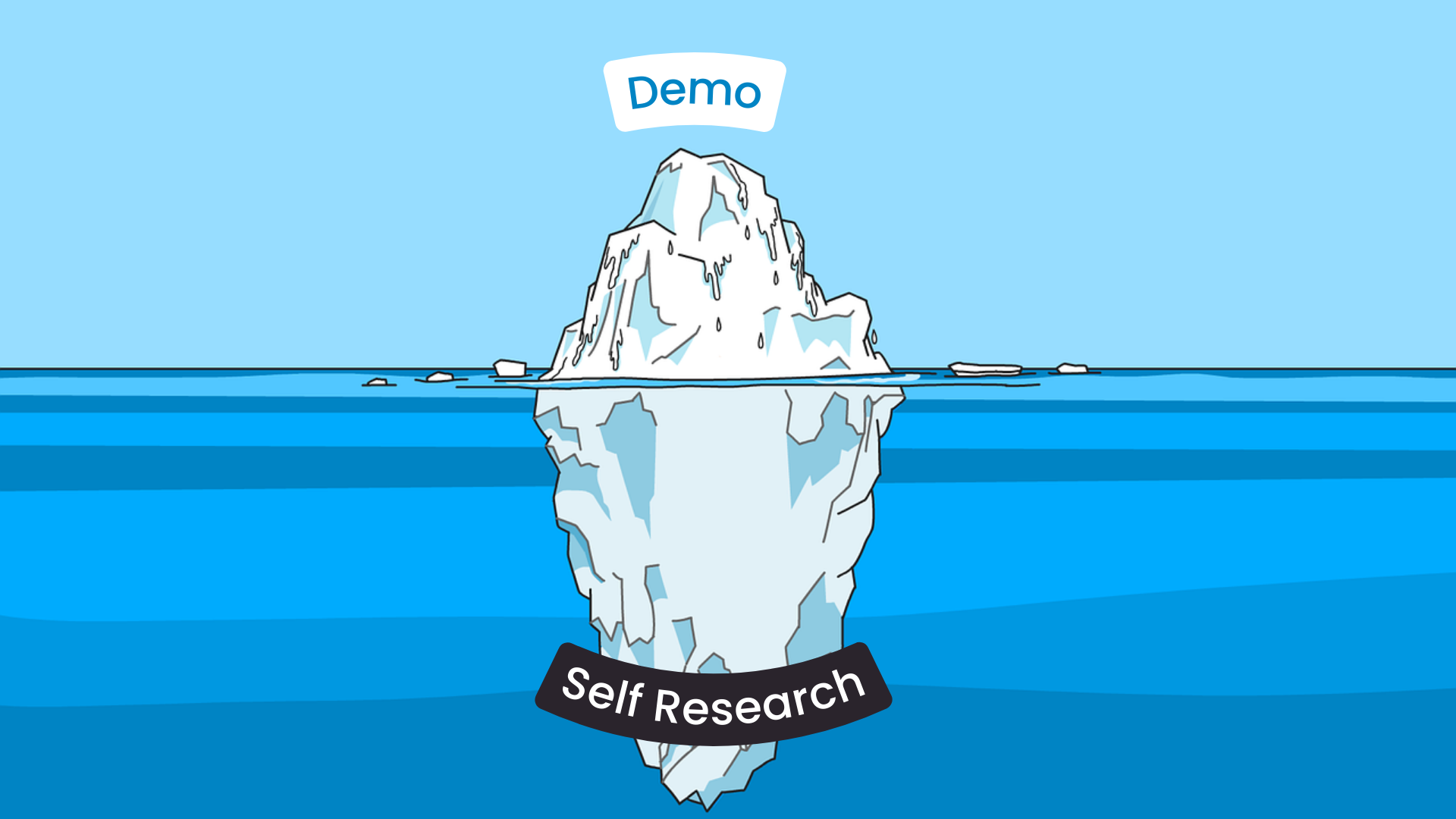
I.e. you often win or lose deals because of the information they find on the internet about you.
Think about the action items I've shared in this article. Even if your decision makers aren't using LLMs, the answers generated by LLMs are a pretty good summary of what someone who does thorough research about your company in a sales process would conclude.
Here's who should and shouldn't invest in an AI search optimization program:
- You should not invest in an AISO program if you have less than 10 non-resource pages on your website. Focus on creating more bottom-of-the-funnel pages first.
- You can consider deprioritizing an AISO program if your industry doesn't have a lot of inherent demand that you can capture and has to rely heavily on demand gen. The easiest way to know whether this is the case is if you don't have good bottom-of-the-funnel search volume on Google search. (Ask your SEO/ads team.) In this case, you'll primarily benefit from the increased sales/free trial conversion rates, but you probably won't see a huge volume of conversions from clicks being driven by LLMs.
- In all other cases, I would highly recommend B2B companies to start an AISO program. It is already driving pipeline today, and this will only rapidly increase over time.
Step 1 is creating a plan. If you don't have a budget to allocate to tools, I've outlined exactly how you can run this program without any tools in this guide.
If you have the budget, I highly recommend trying out Chosenly.com. If you're deciding between Chosenly.com or any other tools on the market, look at a product demo(or screenshots on their website) and ask yourself how exactly you'll use the information showcased in each section. I obviously am biased, but Chosenly.com is by far the most actionable tool on the market.
Schedule a call with us to get access to all the Chosenly.com dashboards I've showcased in the guide and more.
We're offering a POC for $500 for a single month if you want to test it out, or, a $400/month yearly plan.
For a limited number of clients, we're implementing the entire AISO program end-to-end; This white glove program starts at $4000/month for 3 months (i.e., a total investment of $12,000.)

